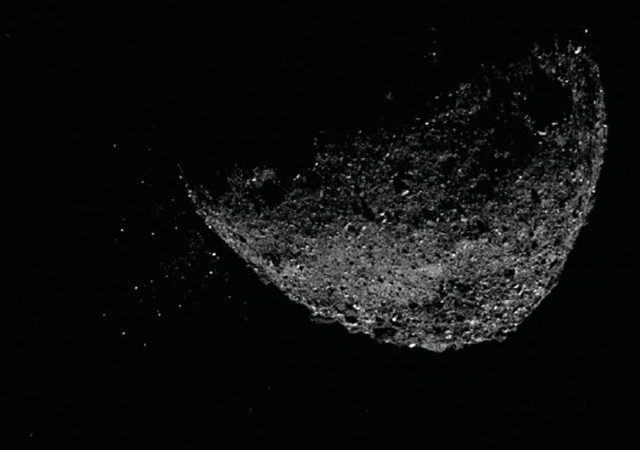The eruptions may hurl meteors toward Earth.
Source: Space.com
For the first time, astronomers have gotten an up-close view of eruptions from an asteroid, shedding light on what might drive such explosions.
The findings suggest that many asteroids may be similarly active and reveal that rocks blasting off of asteroids may be a new way for meteorites to reach Earth, the scientists wrote in a new study.
Astronomers have discovered more than 20,000 so-called near-Earth asteroids, or space rocks whose orbits pass within about 30 million miles (50 million kilometers) of Earth’s orbit. Whereas comets erupt with long tails of gas, dust and debris when they streak near the sun, the vast majority of near-Earth asteroids appear inert.
However, previous research found that a small number of asteroids, such as the asteroid 133P/Elst-Pizarro, could actively erupt with large amounts of dust and bits of rock — enough to create temporary clouds or comet-like tails that are visible from Earth-based telescopes. Much remains unknown about what drives such outbursts in active asteroids.
Now, scientists have captured images of eruptions from the near-Earth asteroid Bennu. “This is the first view of an active asteroid this close up,” study co-author Harold Connolly, a cosmochemist and chair of geology at Rowan University in Glassboro, New Jersey, and a sample scientist for the OSIRIS-REx mission, told Space.com.
NASA’s OSIRIS-REx (Origins, Spectral Interpretation, Resource Identification, and Security-Regolith Explorer) spacecraft arrived at the roughly spherical 1,640-foot-wide (500 meters) Bennu in late 2018. Bennu is likely a “rubble pile” — a collection of boulders held together mainly by their own gravity, with plenty of empty space in between.
Prior work found that Bennu is likely carbonaceous, or rich in carbon. In fact, it’s probably similar in composition to carbon-rich meteorites found on Earth called carbonaceous chondrites. Scientists chose to send OSIRIS-REx to Bennu because the space rock looks similar to known active asteroids. But they hadn’t seen any eruptions from Bennu until now.
When analyzing images of Bennu from OSIRIS-REx’s navigation camera, study co-lead author Carl Hergenrother, an astronomer at the University of Arizona, Tucson, said, “What are these stars?” Connolly recalled. But those spots of light did not turn out to be stars. Instead, they were particles that Bennu had ejected, and they were traveling just above the asteroid’s surface, Connolly said.
The researchers spotted three large eruptions from Bennu in January and February of this year, each ejecting a maximum of 200 chunks up to 4 inches (10 centimeters) across at top speeds of about 7.4 mph (11.9 km/h). They also detected eight smaller eruptions that ejected about 20 or fewer bits of asteroid.
In addition, the scientists discovered six chunks of rock around Bennu that they suggested were ejected during eruptions and stayed gravitationally bound to the asteroid. Some ultimately escaped into interplanetary space, and the others eventually fell back to Bennu’s surface.
The three largest eruptions happened in the late afternoon on Bennu, in places where the sun was about to set. This finding suggests that heating may play a role in these outbursts, as surface temperatures on Bennu can vary by 180 degrees Fahrenheit (100 degrees Celsius) every 4.3 hours, the scientists said. Although the researchers have not seen ice on Bennu, they have detected rich amounts of water-bearing minerals on its surface, and heat from the sun might lead to releases of gas. Another possibility is that such extreme temperature variations may lead boulders to crack and catastrophically burst. Finally, the researchers suggested that meteorite impacts might also cause these explosions.
These findings suggest that all carbonaceous asteroids may be active. “We didn’t see this when [the Japanese space agency’s spacecraft] Hayabusa2 arrived at the asteroid Ryugu, but maybe we didn’t look close enough,” Connolly said. “This may be a new way for meteorites to get to Earth.”
The main purpose of OSIRIS-REx is to collect a sample from the surface of Bennu in 2020 and return it to Earth for analysis in 2023, and the spacecraft has been analyzing the asteroid since the beginning of this year to find an ideal site to sample. “When a sample comes back, we can see if these ejections are perhaps related to the composition of the underlying material,” Connolly said.
Future research can look for more eruptions from Bennu, Connolly said. Scientists can also search the asteroids for craters that might have originated as sites of either eruptions or impacts of erupted material, he added.
The scientists detailed their findings in the Dec. 6 issue of the journal Science.
Source: Space.com

































Leave a Comment
You must be logged in to post a comment.